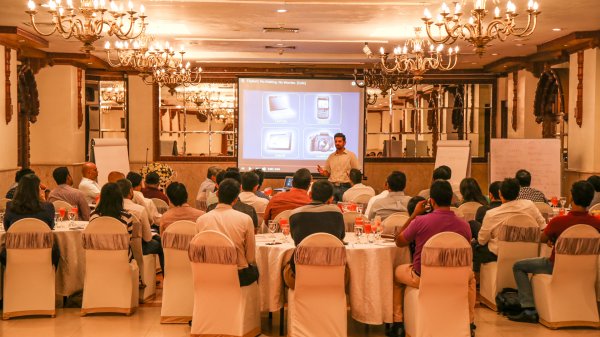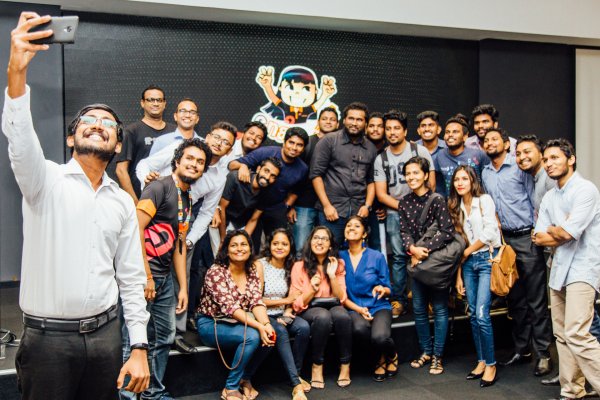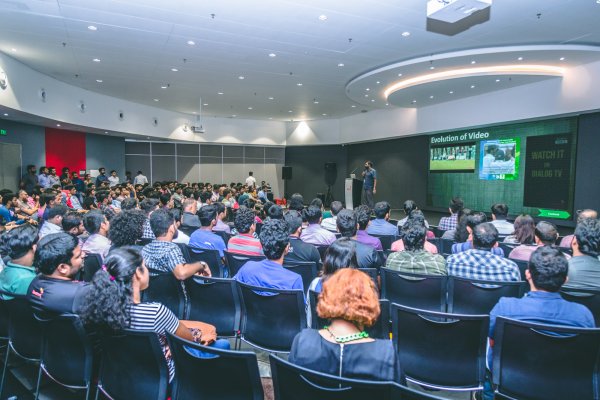
#ngage is an open forum organised by Dialog, where tech and social media enthusiasts can come together, interact, and engage ideas.
On March 22, Dialog hosted its 4th edition of its #ngage meetup at the Dialog HQ down Union Place. ‘Social Media’ was the theme of #ngage 4.0, which aimed at providing those who are actively involved, or perhaps looking to expand their social outreach, an invitation into the lives of people that have used social media and digital channels to create and/or improve their own brand. The topics covered were: creating visual stories on social media, the difficulties of growing a startup digital media company, and what strategies you can use to make your content go viral.

Photo Credit – Nazly Ahmed
Speaking at the event were Amalini De Sayrah (Media and Communications at CPA) on Storytelling Using Instagram, Gazala Anver (Editor-in-Chief at Roar Media) on Roar’s Journey, and Kasun Gunasekera (YouTuber/Software Engineer) on How to Go Viral Overnight.
Storytelling Using Instagram

Photo Credit – Nazly Ahmed
Instagram has become a premier social media platform, and while it may be better-known for your everyday photos of food, to post make-up selfies, to travel shots and humour, local Instagrammer Amalini De Sayrah isn’t one to join in the crowd. With over 2,000 loyal followers and over 1,000 posts, Amalini caters to a niche of Instagrammers who are looking for visual stories beyond memes and selfies. As her presentation played, the audience was shown an image of a young man staring out into the sunlight from a corner of the Rio Cinema. This photo, like many of Amalini’s other snaps, intends to show how urban decay has affected some of Sri Lanka’s most historic buildings.
Amalini’s story snaps attract both praise and censure. By highlighting the problems the less-privileged face in Sri Lanka, Amalini noted that she has had to deal with a lot of criticism for supposedly portraying Sri Lanka in a negative light. But this criticism has not deterred her: Amalini continues to bring to light the many social and environmental issues that Sri Lankans face, without sugar-coating it to appease anyone.
So how does one find a compelling story to tell via pictures?
When photographing people, Amalini says, the key is to make sure that the subject is comfortable with being photographed. It is also important to identify whether you’re taking a photo for its perceived beauty, or because you feel there is more to the picture, a story behind it. To truly convey a story, depicting your subject in its natural environment is important.
Unlike some Instagrammers who have entire digital teams behind them, Amalini doesn’t have any form of marketing or growth strategy; rather, her focus is strictly on presenting Sri Lanka as it is. It’s a whatever-happens-happens approach with little to no care on monetising, with more focus on starting a discussion that will result in social change.
For those interested, Amalini is working towards organising Instameet, an Instagram-based meetup for those that use the platform. The next meet will be held in Negombo, and you can contact Amalini through her social channels for more details.
Roar’s Journey

Photo Credit – Nazly Ahmed
Roar Media’s growth from a digital media startup that catered to the local English-speaking audience, to its current status as a media platform that provides content in five different languages across seven different sites, has not been a walk in the park.
Like most startups in Sri Lanka, Roar did not have the millions of dollars that are regularly pumped into startups over in the US by VCs and Angel Investors. The struggle to find a revenue stream in Sri Lanka whilst maintaining integrity has always been a slippery slope, and has resulted in many media platforms becoming a mouthpiece for its sponsors. So how did Roar go about avoiding this pitfall?
Funding for Roar had been been tricky from the start, but with Roar’s prioritisation of quality over quantity, and its growing viewership, Roar has grown in popularity over years despite the myth that clickbait sells and that online readers only want quick, substance-less content. For other media companies looking for revenue, Roar’s model may not be commonplace, but it allows them to keep their vision alive.
Speaking at #ngage, Editor-in-chief, Gazala Anver, pointed out that while the temptation to increase revenue by aiming for quantity over quality will always be knocking at the door, Roar has shown no interest in resorting to the usual models available to digital media.
How To Go Viral Overnight

Photo Credit – Nazly Ahmed
With an audience seemingly filled with his fans, Kasun Gunasekera, better known as Kalumalli, took to the stage to provide a few pointers on how he has managed to take his ideas and make them go viral.
Kasun hasn’t necessarily filled a niche, for his content varies in nature, ranging from videos about misheard Sinhala lyrics, to Donald Trump attuned to a Sinhala song, to memes of Sri Lankan pickup lines. Kalumalli makes it clear, and his content speaks for itself, that his focus is purely on Sri Lanka.
With his day job as a software engineer at Zone 24/7, Kasun is not a full-time YouTuber like PewDiePie or NigaHiga. Kalumalli’s viewership on a global scale may seem small, but he has a loyal following on his social media channels and his fanbase continues to grow as his content spreads. So what are Kalumalli’s tips on going viral?
Kallumalli believes that keeping it simple is the best approach. A simple idea or a premise seems to have worked for him. He also adds that it is crucial to understand your target audience well, and to get a feel of what’s trending to make sure your content is relevant. Shots in the dark may not work. By understanding your audience and targeting them, the chances of going viral are much higher.
Another simple tip is to ensure that your content matches your audience. Using an example based on his own experience, he explained how one of his older videos was initially distributed with its thumbnail in English, despite the video content being in Sinhala. After making the decision to edit the video and re-upload it with a Sinhala thumbnail, the video instantly went viral. It was clear that this minor change made his content approachable to his target audience and that minor details can be in the world of viral videos.
Like with any content, there is an element of luck involved, too. It’s not an easy landscape, although many may believe it to be, nor is it a case of becoming successful overnight as it is often portrayed.
Given that the digital boom is slowly catching up with Sri Lanka, it will be interesting to see how these insights into digital content would change how newcomers to the field approach it.
Dialog is Sri Lanka’s No.1 Brand on Facebook (1.7 million Fans), Twitter (260K followers) and Viber Public Chat (235K followers) making it the largest and most popular brand online. Dialog was recently awarded the Most Connected Brand by LMD, in a digital study conduct by TNS Lanka, and its latest Viber Sticker Pack ‘Ridmeta Rockwela’ has reached over 2.5 million Viber users.







